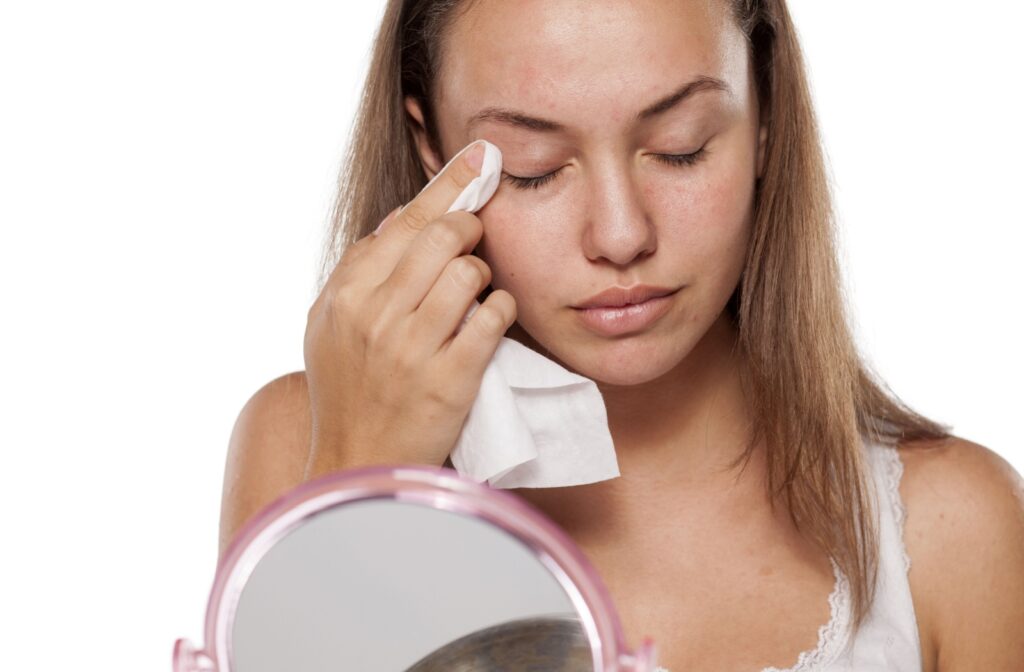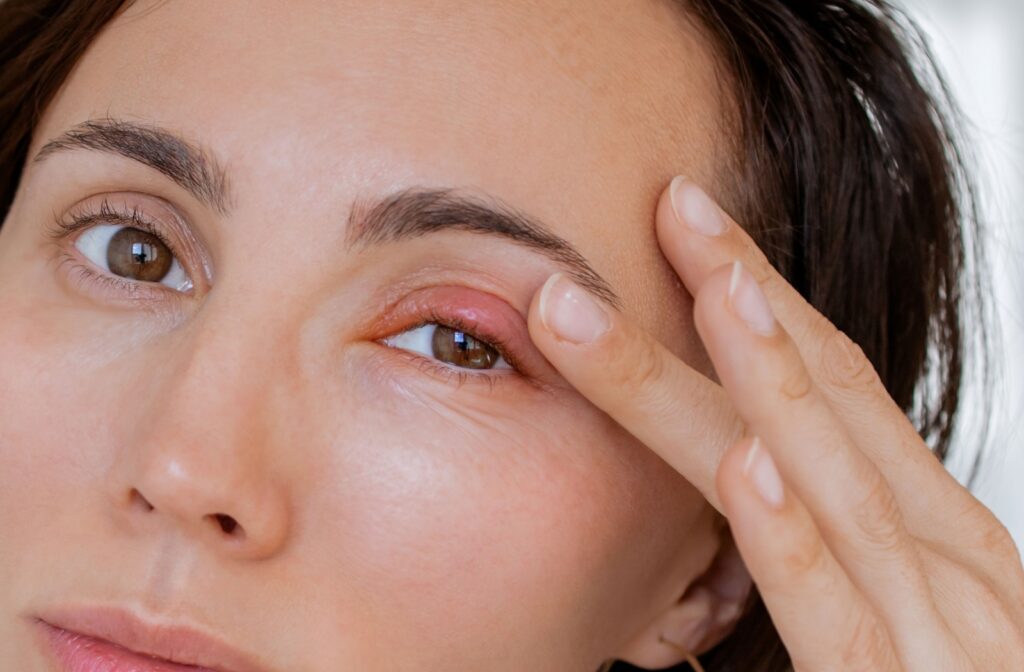Waking up with a tender, red bump on your eyelid is an unwelcome surprise. It goes without saying that you want to keep your eyes healthy and understand how your vision habits contribute to your overall well-being.
Contact lenses do not directly cause styes, but your hygiene habits can contribute to the conditions that causes styes to occur. Understanding the link between your routine and your eye health can help you avoid this common irritation.
Proper care is the key to comfortable contact lens wear.
What Is a Stye?
A stye, also known as a hordeolum, is a small, painful red bump that forms on your eyelid. It happens when an oil gland or eyelash follicle along the eyelid’s edge becomes blocked. Bacteria can then get trapped inside, leading to an infection that may even cause temporary blurred vision.
Two Types Of Styes
Styes can appear in a couple of different spots on your eyelid. They are generally categorized based on their location.
- External Styes: These are more common and form on the outside of your eyelid. They are often the result of an infected eyelash follicle.
- Internal Styes: These develop on the inner surface of your eyelid. An infected oil gland inside the eyelid is the usual cause.
Common Signs & Symptoms Of A Stye
A stye often looks and feels like a pimple right on your eyelid. It’s important to resist the urge to squeeze it, as that can spread the infection and make things worse. You may also experience some other symptoms:
- A red, swollen bump on the eyelid
- Soreness or pain around the bump
- Sensitivity to bright light
- A gritty feeling like something is in your eye
- Watery eyes or crusting along the eyelid
What Triggers A Stye?
Styes are typically caused by common bacteria, often from your own skin. Certain habits or conditions can make it easier for these bacteria to cause an infection. Good hygiene can make a significant difference.
Blocked Oil Glands & Follicles
Your eyelids are lined with tiny glands that produce oil to help lubricate your eyes. If these glands or your eyelash follicles become clogged with dead skin cells or old oil, bacteria can multiply. This blockage and subsequent infection lead to the formation of a stye.
Poor Hygiene Habits
Touching your eyes frequently with unwashed hands is a primary way to transfer bacteria to your eyelids. Forgetting to remove eye makeup before bed or using old cosmetics can also clog glands. These simple habits can increase your chances of developing a stye.

Contact Lenses & Stye Complications
While contact lenses don’t directly cause styes, they can introduce complications if you already have one. Your contact lens habits can also influence your overall risk. Taking a short break from your lenses is often a good idea during healing.
Will Wearing Contacts Make A Stye Worse?
You should switch to your glasses while a stye is healing. A contact lens can increase irritation by rubbing against the swollen eyelid. It may also trap bacteria near the eye, which could delay healing or lead to a more widespread infection.
Do You Need to Throw Away Your Contacts After A Stye?
It’s a smart move to discard the pair of contact lenses you were wearing when your stye appeared, especially if they are monthly or bi-weekly lenses. This helps prevent the bacteria from being reintroduced to your eye. You should also replace your contact lens case to be safe.
Simple Tips for Stye Relief & Prevention
Good eye hygiene is the foundation for both managing a current stye and preventing future ones. These simple practices can help keep your eyelids clean and clear. Consistency is the most important part of any prevention routine.
Keep Your Hands & Face Clean
Wash your hands thoroughly before touching your eyes, putting in contacts, or taking them out. Clean your face daily and be sure to remove all makeup before you sleep. This reduces the amount of bacteria and debris near your eyelids.
Try A Warm Compress
A warm compress is a simple at-home method for relief. Just soak a clean washcloth in warm water, wring it out, and gently place it over your closed eye for 5 to 10 minutes. Repeating this a few times a day can help the blocked gland open up and drain.
Practice Proper Contact Lens Care
Always follow the recommended schedule for cleaning and replacing your contact lenses. Use fresh, approved contact lens solution every time—and remember that lens solution is not a substitute for eye drops. Proper care helps reduce the amount of bacteria that comes into contact with your eyes.
When To Visit An Eye Doctor In Pasadena
Most styes resolve on their own within a week or so with simple home care. However, some situations may call for a visit to a professional. If your stye is causing significant pain or affecting your vision, it’s time to get it checked.
For A Clear Diagnosis
If you aren’t sure if you have a stye or something else, an eye doctor in Pasadena can provide a clear diagnosis. During a comprehensive eye exam, they can examine your eye to confirm the cause of your discomfort. This helps you get on the right track for relief.
Professional Treatment Options
For a stye that is large, extremely painful, or simply won’t go away, an eye doctor has other options. This could be considered an urgent eye care situation where professional help is needed. They may suggest a prescription antibiotic ointment to fight the infection. In some cases, they can perform a simple in-office procedure to drain the stye and speed up healing.
If you have a stye that won’t go away or other concerns about your eye health, our team at Total Vision Pasadena is here to help. Schedule an appointment with us and get the care you need.




